Raw material traceability in handicraft ensures authenticity and quality by tracking the origin of each component, enhancing consumer trust and sustainability. Mixed material sourcing, however, offers design flexibility and cost efficiency but may compromise transparency and consistent quality. Prioritizing traceability supports ethical craftsmanship and long-term brand value in the artisan market.
Table of Comparison
| Aspect | Raw Material Traceability | Mixed Material Sourcing |
|---|---|---|
| Definition | Tracking each raw material's origin and supply chain in handicraft production. | Combining different raw materials from various sources without individual tracking. |
| Transparency | High transparency; full visibility of raw material source and journey. | Low transparency; mixed sourcing reduces clarity of origin. |
| Quality Control | Enhanced quality control by verifying each material's authenticity. | Challenging to ensure consistent quality across mixed materials. |
| Traceability Benefits | Supports ethical sourcing, sustainability, and brand trust. | Less effective in proving sustainability or ethical compliance. |
| Cost Implications | Higher costs due to detailed tracking and validation. | Lower costs; bulk material sourcing without granular tracking. |
| Supply Chain Complexity | More complex; requires detailed record-keeping and supplier cooperation. | Simplified supply chain management with fewer tracking requirements. |
| Best Use Case | Handicrafts prioritizing authenticity, sustainability, and premium branding. | Mass production or non-premium handicrafts focusing on cost efficiency. |
Understanding Raw Material Traceability in Handicrafts
Raw material traceability in handicrafts ensures the origin, quality, and sustainability of each component, enhancing transparency and consumer trust. It involves tracking materials from their source through every production stage, which contrasts with mixed material sourcing where materials are combined without detailed origin records. This traceability supports ethical practices, quality assurance, and compliance with environmental standards in the handicraft industry.
The Concept of Mixed Material Sourcing in Artisanal Production
Mixed material sourcing in artisanal production involves combining various raw materials from different origins to create unique handicraft products, enhancing creativity and design diversity. This approach often challenges raw material traceability due to the complexity of tracking multiple sources, which can impact quality assurance and sustainability efforts. Artisans balance these factors by implementing selective sourcing strategies and transparent supply chain documentation to maintain authenticity and ethical standards.
Importance of Traceability for Handicraft Brands
Traceability of raw materials is crucial for handicraft brands aiming to ensure product authenticity, ethical sourcing, and sustainability compliance, fostering consumer trust and brand integrity. Handicraft products often rely on unique, locally sourced fibers or raw substances, making traceability essential to verify origin and quality standards. In contrast, mixed material sourcing can obscure supply chains, increasing the risk of counterfeit materials and environmental harm, which negatively impacts brand reputation and consumer confidence.
Risks of Mixed Material Sourcing for Handicraft Businesses
Mixed material sourcing in handicraft businesses poses significant risks due to the lack of raw material traceability, which can lead to quality inconsistencies and difficulty in verifying ethical or sustainable origins. This uncertainty threatens brand reputation, especially when consumers demand transparency about the origin of natural fibers, dyes, or woods. Furthermore, mixed sourcing complicates compliance with international trade regulations and certifications specific to handicraft materials, increasing the risk of legal penalties and market access restrictions.
Impact on Product Authenticity and Consumer Trust
Raw material traceability in handicraft ensures each component's origin is verifiable, significantly enhancing product authenticity and strengthening consumer trust. Mixed material sourcing obscures the provenance, often leading to doubts about craftsmanship quality and ethical practices. Transparent supply chains enable artisans to validate authenticity claims, fostering long-term brand loyalty and consumer confidence.
Supply Chain Transparency: Traceability vs Sourcing Practices
Raw material traceability in handicraft ensures full transparency by tracking the origin and journey of each component, enabling ethical sourcing and quality verification throughout the supply chain. In contrast, mixed material sourcing often lacks detailed lineage, making it challenging to verify sustainability credentials or labor standards, which can obscure supply chain accountability. Prioritizing traceability over aggregated sourcing practices enhances consumer trust and supports regulatory compliance by providing clear, verifiable data on material provenance.
Sustainability Implications in Material Sourcing
Raw material traceability in handicraft ensures transparency in the supply chain, enabling artisans and consumers to verify the ecological and ethical origins of materials, thereby fostering sustainable practices. Mixed material sourcing, while potentially increasing efficiency and reducing costs, can obscure the provenance of components, complicating efforts to assess environmental impact and uphold sustainability standards. Prioritizing traceability supports responsible harvesting, reduces waste, and promotes fair labor conditions, crucial for sustaining both artisan communities and natural resources.
Cost Considerations: Traceable Materials vs Mixed Sources
Traceable raw materials often incur higher costs due to rigorous documentation and supply chain transparency, which ensure authenticity and ethical sourcing in handicrafts. Mixed material sourcing reduces expenses by combining inputs from multiple suppliers, but may compromise quality control and traceability, impacting the product's market value. Cost considerations require balancing upfront investment in traceable materials with potential long-term gains from brand reputation and consumer trust.
Leveraging Technology for Raw Material Tracking
Leveraging technology for raw material tracking enhances transparency and authenticity in handicraft production by enabling precise traceability from source to finished product. Advanced blockchain systems and IoT sensors create immutable records, combating fraud and ensuring ethical sourcing in complex supply chains. This digital transformation supports sustainable practices, empowers artisans, and builds consumer trust in handcrafted goods.
Choosing the Right Sourcing Strategy for Handicraft Success
Raw material traceability ensures transparency and authenticity in handicraft products by tracking the origin and journey of each component, enhancing consumer trust and brand value. Mixed material sourcing offers flexibility and cost-efficiency by combining various suppliers and materials, supporting innovation and scalability in production. Evaluating factors such as quality control, supply chain reliability, and target market preferences guides artisans in selecting the optimal sourcing strategy for sustained handicraft success.
Raw Material Traceability vs Mixed Material Sourcing Infographic

 bizdif.com
bizdif.com